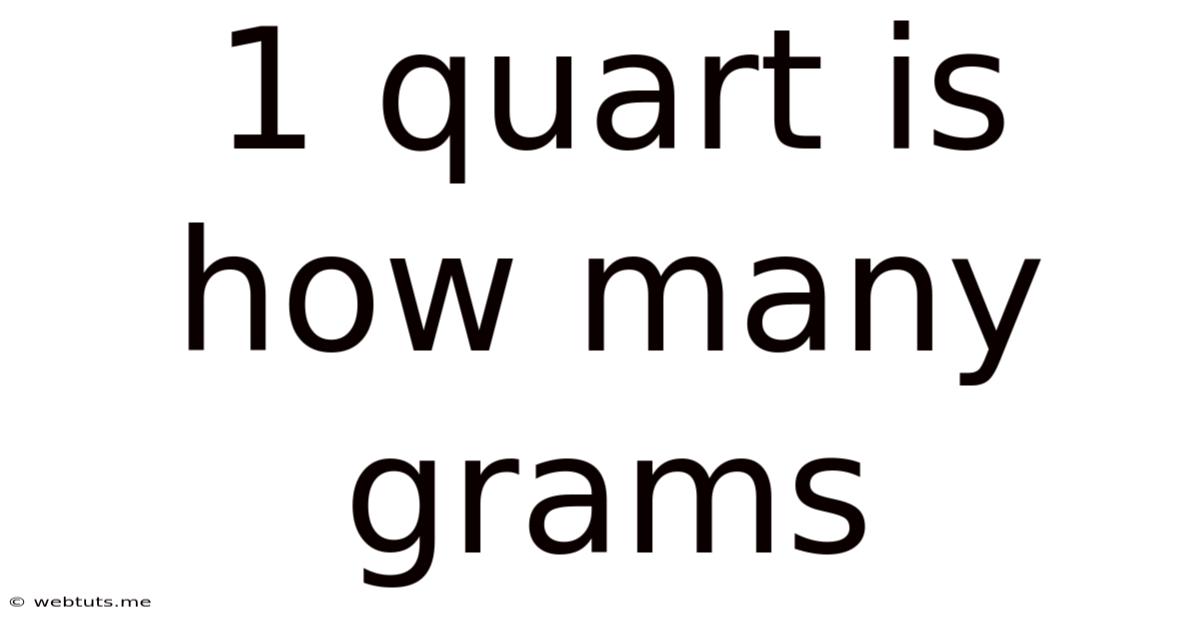1 Quart Is How Many Grams
Webtuts
May 13, 2025 · 4 min read

Table of Contents
1 Quart is How Many Grams? Understanding Volume and Weight Conversions
Converting between units of volume and weight (or mass) requires understanding the substance being measured. A quart is a unit of volume, while a gram is a unit of mass. You can't directly convert quarts to grams without knowing the density of the substance. Density is the mass per unit volume, typically expressed as grams per cubic centimeter (g/cm³) or grams per milliliter (g/mL). Since 1 milliliter is equal to 1 cubic centimeter, these units are interchangeable in this context.
This article will delve deep into the complexities of this conversion, providing a thorough understanding of the underlying principles and offering practical examples to solidify your grasp of the concept. We'll explore different substances and their densities, explain the calculation process, and address common misconceptions surrounding volume-to-weight conversions.
The Importance of Density
The key to converting quarts to grams is density. Density varies greatly depending on the substance. For example:
- Water: At 4°C (39.2°F), the density of water is approximately 1 g/mL. This is a crucial reference point for many conversions.
- Milk: The density of milk is slightly higher than water, typically around 1.03 g/mL.
- Oil: The density of oil varies depending on the type, but it's generally less than water, often around 0.9 g/mL.
- Mercury: Mercury is much denser than water, with a density of approximately 13.6 g/mL.
This difference in density highlights why a direct quart-to-gram conversion is impossible without specifying the substance. One quart of water will weigh significantly less than one quart of mercury.
The Conversion Process: A Step-by-Step Guide
To convert quarts to grams, follow these steps:
-
Determine the substance: Identify the material you're working with. This is the most crucial step.
-
Find the density: Look up the density of the substance. You can find this information in various scientific handbooks, online databases, or chemistry textbooks. Ensure the density is expressed in grams per milliliter (g/mL) or grams per cubic centimeter (g/cm³).
-
Convert quarts to milliliters: Since density is typically expressed in g/mL, it's essential to convert quarts to milliliters. There are approximately 946.35 milliliters in one US liquid quart.
-
Perform the calculation: Multiply the volume in milliliters by the density of the substance. This will give you the mass in grams.
Formula: Mass (grams) = Volume (mL) x Density (g/mL)
Examples: Illustrating the Conversion
Let's illustrate the conversion process with some examples:
Example 1: Water
Let's find the mass of one quart of water:
- Substance: Water
- Density: 1 g/mL (approximately)
- Volume: 1 quart = 946.35 mL
- Calculation: Mass = 946.35 mL x 1 g/mL = 946.35 grams
Therefore, one quart of water weighs approximately 946.35 grams.
Example 2: Milk
Let's find the mass of one quart of milk:
- Substance: Milk
- Density: 1.03 g/mL (approximately)
- Volume: 1 quart = 946.35 mL
- Calculation: Mass = 946.35 mL x 1.03 g/mL = 975.07 grams (approximately)
Therefore, one quart of milk weighs approximately 975.07 grams.
Example 3: Vegetable Oil
Let's find the mass of one quart of vegetable oil:
- Substance: Vegetable Oil
- Density: 0.9 g/mL (approximately)
- Volume: 1 quart = 946.35 mL
- Calculation: Mass = 946.35 mL x 0.9 g/mL = 851.72 grams (approximately)
Therefore, one quart of vegetable oil weighs approximately 851.72 grams.
Understanding the Limitations
It's crucial to acknowledge the limitations of this conversion:
-
Temperature Dependence: Density can change with temperature. The densities used in our examples are approximations and may vary slightly depending on the temperature.
-
Variations within Substances: The density of a substance can vary based on its purity, composition, and other factors. For highly precise measurements, you need to use the exact density value for the specific substance at the specific temperature.
-
Accuracy of Measurements: The accuracy of the final mass depends on the accuracy of both the volume measurement and the density value used.
Beyond the Basics: Advanced Considerations
For more complex scenarios, you may need to consider additional factors:
-
Pressure: At higher pressures, the density of a substance may increase. This is especially relevant for gases.
-
State of Matter: The density of a substance is highly dependent on its physical state (solid, liquid, or gas).
-
Mixtures and Solutions: When dealing with mixtures or solutions, calculating the density requires a more nuanced approach, often involving the densities and proportions of individual components.
Conclusion: Mastering Quart-to-Gram Conversions
Converting quarts to grams requires a clear understanding of density and the specific substance being measured. There isn't a universal conversion factor; the relationship is always mediated by the material's density. This guide provides a practical framework for tackling these conversions, emphasizing the importance of accuracy and attention to detail. Remember to always use the appropriate density value for the substance and conditions at hand to achieve accurate results. By following the steps outlined above and understanding the limitations, you can confidently navigate volume-to-weight conversions in various applications. Remember to always double-check your units and ensure consistency throughout your calculations.
Latest Posts
Latest Posts
-
How To Convert Milliampere To Ampere
May 13, 2025
-
How Many Oz In 1000 Ml
May 13, 2025
-
How Many Ounces In 1 5 Pt
May 13, 2025
-
How Many Weeks Are In 15 Years
May 13, 2025
-
4 Km Is How Many Meters
May 13, 2025
Related Post
Thank you for visiting our website which covers about 1 Quart Is How Many Grams . We hope the information provided has been useful to you. Feel free to contact us if you have any questions or need further assistance. See you next time and don't miss to bookmark.